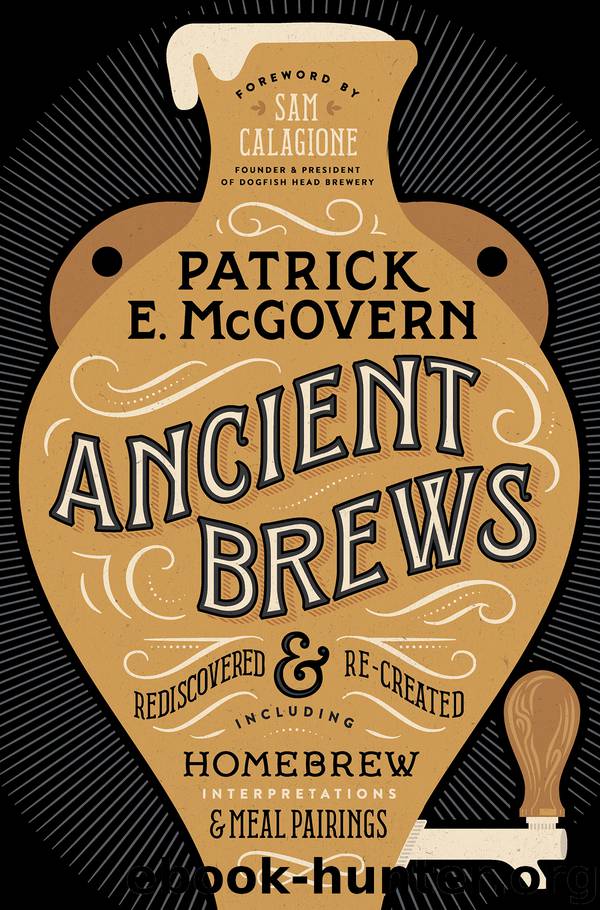Ancient Brews by Patrick E. McGovern

Author:Patrick E. McGovern
Language: eng
Format: epub
Publisher: W. W. Norton & Company
THE PIÈCE DE RÉSISTANCE
THE FINISHING TOUCH to any extreme fermented beverage is its yeast. For Etrusca, I turned to my longtime colleague, Duccio Cavalieri, who had a hand in sequencing the DNA of the yeast responsible for the Scorpion I wine. Duccio is professor of microbiology at the wine and agrarian institute of San Michele all’Adige (Fondazione Edmund Mach) in the Italian Tyrol. He was only too happy to drive the 500 kilometers (300 miles) to Rome and back, so he could be at our opening dinner and tasting at Leo’s brewpub. He rose to his feet many times that evening, as we drank oyster stout from Birra del Borgo, a braggot or honeyed beer from Baladin, and, naturally, Midas Touch, to toast the group and expostulate on yeasts.
Duccio thought long and hard about what would be the best yeast to use for Etrusca. He finally hit upon it. He and his colleagues had already published a paper in which they crossed what they believed were primitive yeasts from Tuscany. One strain was a Saccharomyces cerevisiae, which came from Montalcino. The other strain was S. bayanus, which was isolated from a sample of Vin Santo (Italian, “Holy Wine”), which carries on the ancient Canaanite tradition of first drying the grapes before pressing and fermentation. It was from the general region of the Etruscan sites of Volterra, Fiesole (ancient Florence), and Barberino. He proposed crossing the two species once again, collecting the viable tetraploid spores, and multiplying them to make an “ancient” Etruscan yeast.
As I discussed in Chapter 1, Saccharomyces cerevisiae and S. bayanus are the two main yeast species for fermentation. They had already accidentally crossed in medieval Germany, to give the bottom-dwelling lager yeast, which was isolated and identified in the late 19th century by Emil Hansen of the Carlsberg brewery in Copenhagen and named Saccharomyces carlsbergensis, more properly S. pastorianus.
Duccio’s efforts to intentionally cross the two Tuscan variants once again proved successful, and the offspring hybrid was shown to be cold tolerant and capable of producing high alcohol levels, up to 10%. Samples were sent off to the three microbrewers. Dogfish Head’s yeast laboratory had no problem in multiplying it for batch production in the United States.
Download
This site does not store any files on its server. We only index and link to content provided by other sites. Please contact the content providers to delete copyright contents if any and email us, we'll remove relevant links or contents immediately.
| Beer | Cocktails & Mixed Drinks |
| Coffee & Tea | Homebrewing, Distilling & Wine Making |
| Juices & Smoothies | Wine & Spirits |
101 Whiskies to Try Before You Die by Ian Buxton(44911)
World's Best Whiskies by Dominic Roskrow(44824)
Whiskies Galore by Ian Buxton(41937)
Craft Beer for the Homebrewer by Michael Agnew(18194)
Right Here, Right Now by Georgia Beers(4167)
Not a Diet Book by James Smith(3373)
Water by Ian Miller(3155)
The Coffee Dictionary by Maxwell Colonna-Dashwood(3094)
Kitchen confidential by Anthony Bourdain(3046)
Coffee for One by KJ Fallon(2599)
Smuggler's Cove: Exotic Cocktails, Rum, and the Cult of Tiki by Martin Cate & Rebecca Cate(2495)
Superfood Smoothie Bowls: Delicious, Satisfying, Protein-Packed Blends that Boost Energy and Burn Fat by Chace Daniella(2419)
Beer is proof God loves us by Charles W. Bamforth(2414)
Talking as Fast as I Can by Lauren Graham(2410)
Bourbon: A Savor the South Cookbook by Kathleen Purvis(2263)
A Short History of Drunkenness by Forsyth Mark(2256)
Eat With Intention by Cassandra Bodzak(2172)
Cocktails for the Holidays by Editors of Imbibe magazine(2097)
Colombia Travel Guide by Lonely Planet(2086)
